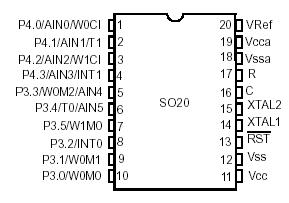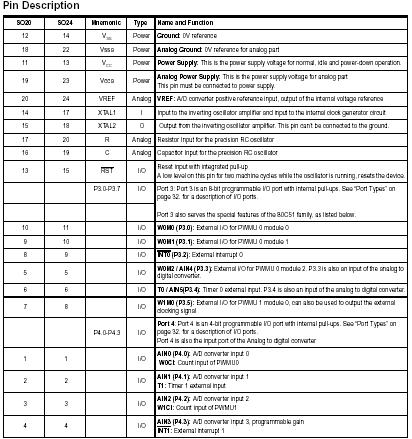Features: • 80C51 Compatible
Two I/O Ports
Two 16-bit Timer/Counters
256 bytes RAM
• 4 Kbytes ROM or 4 Kbytes Flash Program Memory
• 256 bytes EEPROM (Stack Die Packaging Technology on SO20 Package)
• X2 Speed Improvement Capability (6 Clocks/Machine Cycle)
• 10-bit, 6 Channels A/D Converter
One-channel with Progammable Gain and Rectifying Amplifier (Accuracy +/- 5%)
Voltage Reference for A/D & External Analog
• Hardware Watchdog Timer
• Programmable I/O Mode: Standard C51, Input Only, Push-pull, Open Drain
• Asynchronous Port Reset
• Triple System Clock
Crystal or Ceramic Oscillator (24 MHz)
RC Oscillator (12 MHz), with Calibration Factor Using External R and C
(Accuracy +/- 3.5% with Ideal R and C)
RC Oscillator, Low Power Consumption (12 MHz Low Accuracy)
Programmable Prescaler
• One PWM Unit Block With:
16-bits Programmable Counter
3 Independent Modules
• One PWM Unit Block with:
16 bits Programmable Counter
1 Module
• Interrupt Structure With:
7 Interrupt Sources,
4 interrupt Priority Levels
• Power Control Modes:
Idle Mode
Power-down Mode
Power Fail Detect, Power On Reset
Quiet mode for A to D Conversion
• Power Supply: 3 to 3.6V
• Temperature Range: -40 to 85o C
• Package: SO20, SO24 (upon request)
ApplicationSoftware can take advantage of the additional data pointers to both increase speed and reduce code size, for example, block operations (copy, compare, search...) are well served by using one data pointer as a 'source' pointer and the other one as a 'destination' pointer.
ASSEMBLY LANGUAGE
; Block move using dual data pointers
; Destroys DPTR0, DPTR1, A and PSW
; note: DPS exits opposite of entry state
; unless an extra INC AUXR1 is added
;
00A2 AUXR1 EQU 0A2H
;
0000 909000MOV DPTR,#SOURCE ; address of SOURCE
0003 05A2 INC AUXR1 ; switch data pointers
0005 90A000 MOV DPTR,#DEST ; address of DEST
0008 LOOP:
0008 05A2 INC AUXR1 ; switch data pointers
000A E0 MOVX A,@DPTR ; get a byte from SOURCE
000B A3 INC DPTR ; increment SOURCE address
000C 05A2 INC AUXR1 ; switch data pointers
000E F0 MOVX @DPTR,A ; write the byte to DEST
000F A3 INC DPTR ; increment DEST address
0010 70F6JNZ LOOP ; check for 0 terminator
0012 05A2 INC AUXR1 ; (optional) restore DPS
INC is a short (2 bytes) and fast (12 clocks) way to manipulate the DPS bit in the AUXR1 SFR. However, note that the INC instruction does not directly force the DPS bit to a particular state, but simply toggles it. In simple routines, such as the block move example, only the fact that DPS is toggled in the proper sequence matters, not its actual value. In other words, the block move routine works the same whether DPS is '0' or '1' on entry. Observe that without the last instruction (INC AUXR1), the routine will exit with DPS in the opposite state.Pinout
 Specifications
Specifications
Ambient Temperature Under Bias:
C = commercial..................................................... 0°C to 70°C
I = industrial .................................................... -40°C to 85°C
Storage Temperature ................................. -65°C to + 150°C
Voltage on VCC to VSS......................................-0.5 V to + 4.6 V
Voltage on Any Pin to VSS ..........................0.5 V to VCC + 0.5 V
Power Dissipation................................................................. 1 W
Electro-static discharge voltage 1500 V |
DescriptionThe AT8xEB5114 is a high performance version of the 80C51 8-bit microcontroller in a Low Pin Count package.
The AT8xEB5114 retains all the features of the standard 80C51 with 4 Kbytes program memory, 256 bytes of internal RAM, a 7-source, 4-level interrupt system, an onchip oscillator and two timers/counters. AT8xEB5114 may include a serial two wire interface EEPROM housed together with the microcontroller die in the same package.
The AT8xEB5114 is dedicated for analog interfacing applications. For this, it has a 10- bit, 6 channels A/D converter and two PWM units; these PWM blocks provide PWM generation with variable frequency and pulse width.
In addition, the AT8xEB5114 has a Hardware Watchdog Timer and an X2 speed improvement mechanism. The X2 feature allows to keep the same CPU power at a divided by two oscillator frequency. The prescaler allows to decrease CPU and peripherals clock frequency. The fully static design of the AT8xEB5114 allows to reduce system power consumption by bringing the clock frequency down to any value, even DC, without loss of data.
The AT8xEB5114 has 3 software-selectable modes of reduced activity for further reduction in power consumption. In idle mode the CPU is frozen while the peripherals are still operating. In quiet mode, only the A/D converter is operating. In power-down mode the RAM is saved and all other functions are inoperative. Three oscillator sources, crystal, precision RC and low power RC, provide versatile power management.
The AT8xEB5114 is available in low pin count packages (ROM and flash versions).

 AT89EB5114 Data Sheet
AT89EB5114 Data Sheet








